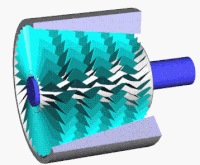
Photo from wikipedia
Abstract There exists a lot of research on the breathing-crack induced nonlinear vibration for beam-like structures. To the best of our knowledge, these studies mainly focus on the non-rotating uniform… Click to show full abstract
Abstract There exists a lot of research on the breathing-crack induced nonlinear vibration for beam-like structures. To the best of our knowledge, these studies mainly focus on the non-rotating uniform beam. Little research on the cracked compressor blade with varying-section and twisted shape has been performed considering the rotational effects (i.e., Coriolis force, stress stiffening, spin softening and angular acceleration) and comparatively accurate crack propagation paths (i.e., semi-elliptical crack). In this paper, typical fatigue cracks analyzed in referenced crack propagation path simulation and experimental tests are introduced into the ANSYS finite element (FE) model of a rotating compressor blade, which accounts for the influence of rotational effects. Then the effects of angular acceleration, amplitude of aerodynamic force and crack parameters (i.e., crack position, crack depth and crack height) on the dynamic characteristics of a cracked compressor blade during run-up process (RUP) are discussed. The results show that the crack-induced second- and third-order super-harmonics can be observed and become more evident with increasing crack severity (i.e. crack position closer to blade root surface or a larger crack depth/height) during RUP. Moreover, aerodynamic force plays a dominant role in affecting crack-breathing behavior at low speeds, while centrifugal force dominates the crack-breathing behavior at high speeds.
Journal Title: Mechanical Systems and Signal Processing
Year Published: 2019
Link to full text (if available)
Share on Social Media: Sign Up to like & get
recommendations!